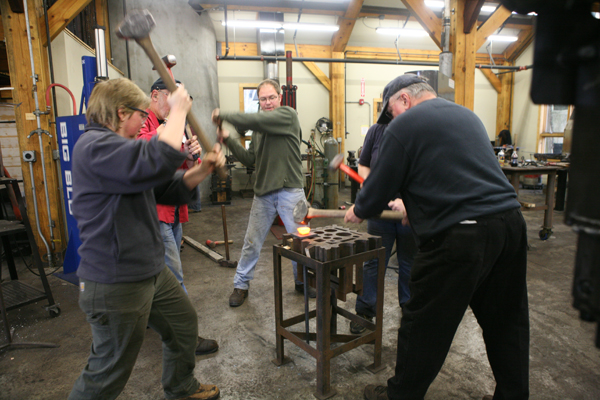
23 Feb Building Blacksmithing Skills with Susan Hutchinson
Another fantastic blacksmithing week is done at the Folk School. The floor is swept, slack tubs filled, the shop keys handed over; for lack of a plausible excuse to tarry longer, I slump into my truck and drive back to the outside world: the inevitable exit blues.This past week’s session was particularly bonded. This is a class of mixed levels, genders, ages and professions. Those who had never started a coal fire catching on quickly watching those who had been there before. Beginners start with a hook; intermediates make hooks that match, and those looking for bigger challenges design beautiful hooks that the world has never seen before that can be produced in a certain time frame to meet a production price point.
Given the fire, noise, and physicality of smithing, these classes tend to be a notch closer to an Outward Bound type of experience than a simple “how to make a something-or-other” workshop. Some courage is required. Willingness to push self imposed boundaries and to experience risk is essential. We are allowed – or rather demanded – to play in the fire, to hit things (hit it like it owes you money), to be like superman bending and twisting solid steel. After such a morning’s work, is it so surprising that when we show up for lunch, folks step out of the way?
Blacksmithing tends to be a team sport, more than most crafts. Two hands are often not enough, and as neighbor helps neighbor, the class becomes a small community. In the evenings we do some team striking to make giant nails; after all, what can possibly be more fun than six people swinging sledges on a lump of white hot metal? Group striking is an exercise in cooperation, trust, and concentration; steel takes huge amounts of energy to form, even hot. Every time one striker makes impact, the next is already started down. Anyone who misses can put the whole group in danger. The metal will cool quickly, and the cooler it gets, the more energy is necessary to form it; we must move quickly and with confidence. By the time the nail is finished a few minutes later, our group is exhilarated and out of breath.
I structure my classes loosely. The necessary basic demos are covered thoroughly, but quickly, and students move on to the projects of their choice. Projects ranged this week from fire pokers to small furniture to free-form sculptures. Sometimes a student wants to work like a banshee to finish a garden gate, sometimes they want to make a small memento and then take in other evening activities that the Folk School offers.
As far I can reckon, teaching blacksmithing has got to be one of the most meaningful things a person can do in this life. It starts with a pile of coal, a few bars of cold steel, and some matches. And it ends up a pile of friends, some useful and beautiful objects, and a new understanding of power, tenacity and fire. Each student has completed a project that is not a mere pair of tongs or candlestick, but a true Hero’s Journey.
Another version of this class is available in August 19-24, 2012 and again next February.
In the meantime, my amazing assistant, Julie Clark, will be teaching “Cock-a-doodle-doo“, a fabricating class constructing steel roosters May 13-18, 2012. This is an great opportunity to learn welding and sculpting skills that complement a foundation in blacksmithing. Julie’s class description: “Create a sculpture that seems to come to life as you add layer upon layer of steel. A variety of techniques will be demonstrated and used to fabricate this fantastic fowl, including blacksmithing, welding, and cutting. This hefty rooster will leave you crowing! Open to all skill levels- perfect for hard-working folks with a sense of humor who want to get started in metalworking.”




No Comments